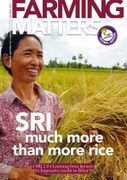Our partner organisations are widely known for the regional editions of this magazine, from AGRIDAPE to LEISA China. Yet there is much more going on, with many different initiatives for disseminating information and exchanging ideas and opinions.
AME: From essays to apps
In early 2013 the AME Foundation joined the smartphone era with the new app for its flagship publication, LEISA India.
And in addition to producing and disseminating LEISA India in different ways, AME has been busy with different information initiatives.
To celebrate World Soil Day on 5 December 2012, for example, AME joined the Society for the Protection of Wasteland Development, one of the largest organisations in India, and arranged a workshop for school pupils and teachers in Delhi.
Films about living soils, produced by different organisations, were used as resource materials, together with different editions of LEISA India. About 18 teachers and 60 students then participated in an essay competition. The students articulated surprisingly well how soils are linked intimately with ecological well being and rural livelihoods.
A few weeks later, the city of Hubli was the scene of an international development dialogue on social entrepreneurship. AME’s Director, K.V.S. Prasad was invited to speak at one of the panels, emphasising the importance of family farmers. Prasad highlighted how farmers are often neglected as a constituency, even though they make up 70 per cent of the rural population in India.
The audience appreciated AME’s promotion of approaches such as Farmer Field Schools as a way to motivate the rural youth, and the notion of farmers as “shareholders” rather than “stakeholders”. The event made clear that agro-ecological approaches are more relevant now than ever, and that the upcoming 2014 International Year of Family Farming is a key moment to advance this type of agriculture.
ALIN: Farmers and ICTs
With support from the Ford Foundation, the Arid Lands Information Network has been piloting an online and mobile phone-based platform known as Sokopepe. Its purpose is to help farmers get real time information about prices and options for commercialising different products, together with a range of other services.
Through an inexpensive SMS service that reaches the whole country, farmers can find out where to get the best price for their products. Armed with this knowledge, they can join others in order to sell larger volumes and thus ensure a higher price. Information is delivered via basic mobile phones, which are increasingly widely available.
“This has enabled previously marginalised sections of society, particularly women and youth, to access market information on an equal footing with men,” notes James Nguo, ALIN’s Regional Director. “The growth of mobile phone technology is changing the situation we saw before, where brokers decided prices for farmers.”
Once this pilot phase is complete, ALIN plans to support farmers to organise themselves into groups around various commodities in order to increase their bargaining power. The Sokopepe system will be scaled out to all of the 12 Maarifa Centres over the next two years, and will be extended to facilitate online transactions through mobile money transfers.
ETC Andes: Rural radio
Eighteen months ago, ETC Andes joined the AGROECO project in Peru – an initiative that aims to analyse the contribution of organic agriculture to food security in the Andean region.
ETC Andes is in charge of disseminating and sharing the results of the project to students, extension agents, researchers and policy makers in the region, and to the thousands of readers of LEISA revista de agroecología.
To better reach out to farmers, ETC has also written Quechua language scripts which have been broadcast since November 2012 by Radio Inti Raymi, based in the southern city of Cusco. ETC opted for a radio programme as the best way to reach those in the rural areas, especially female farmers.
The first 33 programmes have already been aired, all of them discussing the link between local products and the population’s health and nutrition levels. After three months, ETC organised a meeting with farmers who had been tuning to the programme. They stressed the importance of receiving information in their native language about nutrition, the meaning of organic production and nutritious recipes for dishes based on local biodiversity resources. They also requested information about gender issues.
The Cusco Farmers’ Federation has asked that similar programmes be made for other areas. These new scripts are ready, and agreements have been made for the programmes to be broadcast by other radio stations. They will also be available on the Internet.

